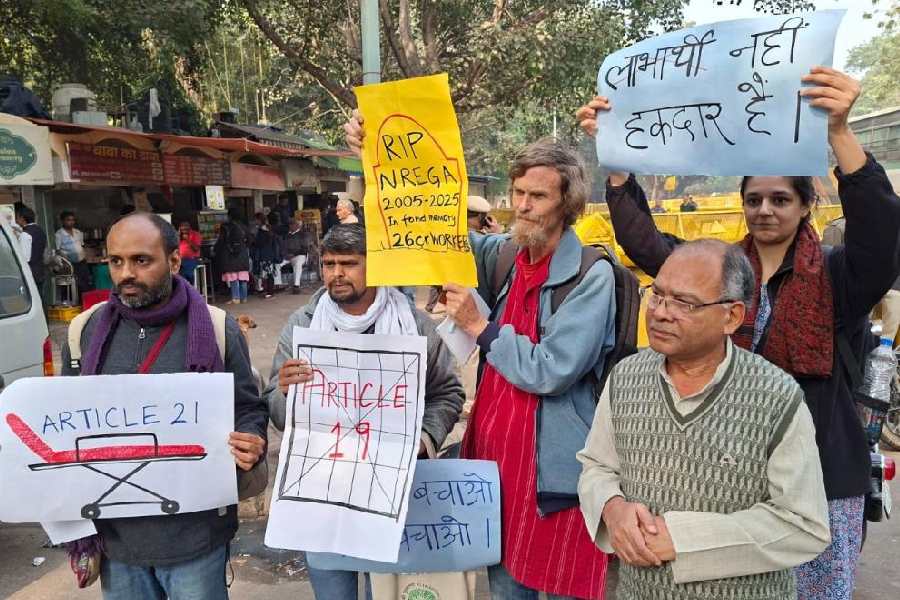.jpg)
It's been a long battle, but Basmati, the aromatic rice that you cook your biryani with, has finally emerged victorious, elbowing out all pretenders to the throne. Not any old rice can be called Basmati. It has to be the variety that grows in the Indo-Gangetic plains.
Last month, it was granted a coveted Geographic Indication (GI) tag. The recognition will help rice growers in 77 districts of six Indian states stave off competition from their counterparts in other states who have taken to Basmati cultivation as the grain variety commands a better price in global and domestic markets.
Regional products are clamouring for a GI tag. Do not mock the Joynagarer Moa. The palm sugar ( nolen gur) and sugary puffed rice sweet joined the exalted league of traditional products identified with a place when it received a certification last year. The sweet, made by the Joynagar Moa Nirmankari Society, a co-operative of traditional sweetmeat makers in Joynagar, 50 kilometres south of Calcutta, was the first Bengali sweet to get the recognition.
A GI tag is granted by the Geographical Indications registry on recommendations of the Chennai-based Intellectual Property Appellate Board (IPAB). Normally granted when a geographical location adds a certain quality to a product, the GI tag also vouches for its authenticity.
India, a signatory to the Trade Related Intellectual Property Rights agreement, passed the Geographical Indications of Goods (Registration and Protection) Act in 1999 and the rules came into force in September 2003.
Darjeeling tea from West Bengal became the first traditional product to get a GI tag in India in 2004. It was closely followed by Aranamula metal mirrors from Kerala and Pochampalli saris from Andhra Pradesh.
.jpg)
"GI can be best described as poor people's intellectual property rights and it is granted to a community rather than an individual or an enterprise," explains R.S. Praveen Raj, a senior scientist with the National Institute of Interdisciplinary Science and Technology, a Council of Scientific and Industrial Research laboratory based in Thiruvananthapuram.
Currently, 238 traditional products have been granted GI certification in India. The products range from the fiery Naga chillies to Madhubani paintings and Kashmiri pashmina.
Ten articles from Bengal have received GI registration so far. Among them are mango varieties Laxman Bhog, Khirsapati and Fazli, Santipur, Baluchari and Dhaniakhali saris, Santiniketan leather goods and Nakshi Kantha.
"Currently there are applications for five goods. These include sweetmeats such as rosogolla, sitabhog and mihidana and rice varieties Gobindobhog and Tulaipanji," says Mahuya Hom Choudhury, a scientist with the Patent Information Centre of the West Bengal State Council of Science and Technology.
GI links a region to a product. Just as Tequila is Mexican, Pashmina has been certified as Kashmiri and Pochampalli as specifically an Andhra style. "It is normally granted to 'goods' that originate in a certain region where a given quality, reputation or other characteristics of the product can essentially be attributed to its geographical location," says Raj, who was earlier a patent examiner.
But the tag doesn't come easily. "Granting of GI tags has been dogged by many controversies," stresses Shamnad Basheer, an Indian legal scholar and founder of SpiceIP blog, a prominent blog and resource on intellectual property rights.
Take the latest one to be granted the GI tag -- Basmati rice, which got its tag on February 15. The Madhya Pradesh government wants Basmati rice growers in the state too to get the certification. The GI registry didn't oblige, prompting the MP government to go to the High Court of Madras. The case is expected to come up in April.
"We may have to make the GI tag available to MP if higher courts rule in the state's favour," says Chinnaraja G. Naidu, assistant registrar at the Geographical Indications Registry in Chennai.
The case has been hanging fire since 2008. Growers of Basmati in the Punjab province of Pakistan had approached the IPAB to oppose the granting of GI to India's Agricultural and Processed Food Products Export Development Authority (Apeda), which represented Basmati growers in six Indian regions - Punjab, Haryana, western Uttar Pradesh, Uttarakhand, Delhi and Jammu and Kashmir. But when Pakistan Basmati growers failed to provide the required evidence about the cultivation of the rice there, Apeda received the certification.
A move to make Basmati a "joint heritage" of India and Pakistan didn't work out as there was staunch opposition to this from Pakistan.
The experts point out that GI tags help mostly in marketing a product. India, which accounts for 85 per cent of Basmati produced in the world, had exports worth Rs 27,600 crore last financial year. With a GI tag, others will not be able to export their rice as Basmati.
.jpg)
Many countries have been able to capitalise on products that have GI tags through aggressive marketing, points out Basheer, who won the 2014 Infosys Prize for Humanities.
Tequila is a good example. Production of this Mexican alcoholic beverage shot up from 105 million litres (ML) in 1995 to 312ML in 2008. It's now down to 234ML, possibly because of a drop in demand related to the global economic slowdown.
Basheer believes that there are many "grey areas" in India's GI Act which need to be addressed. He cites the example of the Tirupati laddu, which was granted a GI in 2009.
Granting a GI tag to a single entity, whether a religious institution or a private enterprise, raises technical questions. Reliance Industries Limited had tried for GI tags for many of its petroleum products citing the "geographical" significance of its Jamnagar refinery. However, it withdrew the applications after meeting with stiff opposition from IPR experts.
Hyderabadi Haleem - a dish of mashed cereals and meat - kicked up a controversy, too. The dish was granted GI in 2010. "Are we trying to say that a chef who has been making haleem in Hyderabad cannot make or name it so when he moves cities," asks Raj, who was in the forefront of opposing GIs to the Tirupati laddu and Hyderabadi Haleem.

Kerala Ayurvedic massage, on the other hand, doesn't have a GI tag yet. "Practictioners of this Kerala massage form can be found all over the world, including in European countries. Which means the practice is already very well dispersed. How can we then consider giving it a GI tag, barring practitioners in other places from calling it 'Kerala Ayurvedic massage'," Basheer asks.
Jayanta Kumar Aikat, director of food processing industries of West Bengal, says that the state has been closely documenting sweetmeats and exploring the potential of filing a GI tag for those which have unique qualities associated with a place, weather and water.
"People who are traditionally involved in making them will benefit financially when these are better packaged, increasing their shelf life, and sold in international markets," he says.
In the meanwhile, rosogolla, for which the Bengal government has filed for a GI tag, is in trouble. The Odisha government says it will oppose the move as it was traditionally made in Odia temples. Watch out for a bitter battle.

.jpg)








